HONG KONG - MELBOURNE - TASMANIA - BANGKOK - MYANMAR
MYANMAR
Due to an administrative
error (I deleted 10 days of
intensive writing about Myanmar); the names of various temples and tiny
villages have been wiped out from memory, mine and the computer’s!
YANGON
(1) BAGAN
LAKE INLAY
YANGON (2)
The flight from Bangkok to Myanmar was uneventful, unlike our ride from the airport to our airport hotel. (see Bangkok account). Our luggage arrived with us in in Yangon, the guide Aung Sue and car from Myanmar Shalom Travel were waiting at the airport and everything seemed fine except that after 10 days with our children in Tasmania we were not really in the mood for more touring. But the magic of Myanmar, its warm and welcoming people and later the water festival captured our hearts and it was hard to leave 8 days later.
Yangon has many colonial buildings, remembering 200 years of British colonial rule. Many are well kept, reminding us of Durban, but we also saw many buildings peeling, moldy and empty, previously occupied by the military dictatorship.. The harsh military dictatorship of previous years is being replaced by steps towards democracy; we never saw a soldier and the only policemen we saw were traffic policemen; many plainclothes policemen abound. The population is overwhelmingly religious and virtually all local tourism is religion based. We were there during the Water Festival and New Year (1375), during which whole families make pilgrimages to various pagodas and temples and sleep over at Buddhist monasteries, with few able to afford any hotel.
We wanted to have
lunch
at a local restaurant. Faced with
Zoe-sized chairs and tables on the pavement (fine for people who squat
down all
the time) we waited for a normal table and chairs to be available.
Lunch,
consisting of rice, soup, chicken, salads and other dishes, some really
tasty,
cost under $4.00 for three people.
An ongoing question in Myanmar was, of course, how was democracy taking shape and what controls did the new government have. We stopped by the walled compund of the freedom fighter and opposition leader Ms. Aung San Sui Kyi; the road that passed her house was previously banned to traffic. We read that she will be allowed to run for president in the next elections after a change in the constitution. One of the things that puzzled us was the phenomenon of plastic jerrycans piled by the roadsides. At first we thought water was being sold; we were informed that this is gasoline. Oh yes, the gas stations are open,but they close early. The bottles (for motorbikes) and jerry cans were openly displayed in all the towns for those who needed fuel in the evening or night.
After lunch we went to a barge that was preparing to sail for various villages on the way to Mandalay. We watched men, young and old, in flip-flops carry 50 kilo bags of salt from the lorry to the barge. The barges were packed with clay stoves, ceramic jars for water, wood burning stoves, kids’ toys, cheap jewelry, furniture and various dried foods. I bought some thanakha wood that is ground to make a paste, then mixed with water and is used against sunburn (when I tried it at Bagan it inflamed my face and I had to quickly rub it off),
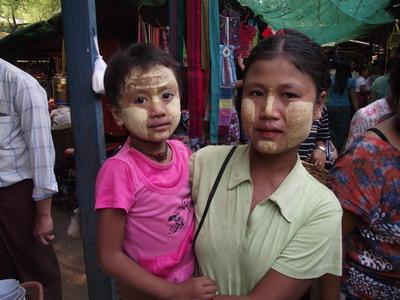
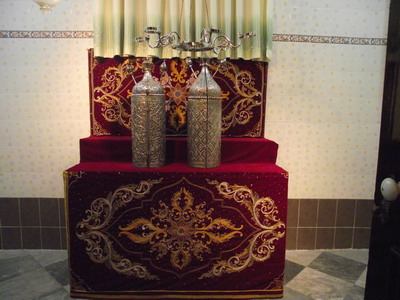
From Yangon we flew to Bagan and then Lake Inlay before returning to Yangon.
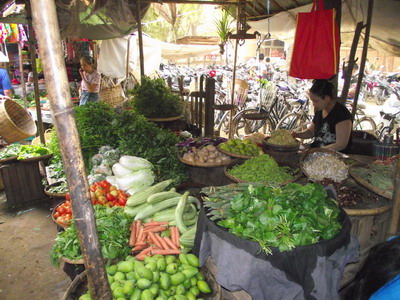
Bagan is situated on the
Ayeryarwaddy River, which is an
important waterway for transporting logged teakwood and other goods,
people and
tourists; it is also where the people draw their water, wash their
clothes and
themselves and where the children play. Our lodge, Thiripyitsayar
Sanctuary Resort, was situated near the
river
amongst lush gardens with our own private pagodas, two of the more than
1,000
pagodas in Bagan. All pagodas in Bagan are old; no new ones are allowed
to be
built there. Pagodas and stupas are made from brick and are solid;
temples are
the walk in ones. Colloquially all are referred to as pagodas.

Many families have festive meals with the monks to celibrate life cycles or events. Here is a picture of a meditating cell, but the dormitories for novice monks are not much more luxurious. We could not reconcile the anomaly of monks on motorbikes or touring and taking photos. The monks are held in huge respect by the local populace and later in Bangkok we saw how people sitting in a bus instantly vacated their seats, actually scattered, when a monk approached
One of the more
interesting
temples
was the three spired temple that had the interior of two of them
decorated and
the third was plastered and even outlined for the decorations but it
was not
completed as the Mongols conquered the area in 1260 (?) and the artists
ran
away. Interestingly at the same time the Mongols conquered Jerusalem on
the
other side of the world and were defeated at the Battle of Ein Jalud
not long
before the Crusaders were finally expelled from our area. We climbed
the78 steps
of Ananda Temple late in the
afternoon. It was an impressive site to see the many spires of pagodas
rising
above the trees, but the red ball of the sun disappeared into the haze
while it
was still high in the sky.
I bought a
Buddha
mask and was delighted to find out that it was Travelling Buddha shown
here on the left as he delicately raises his cloak as he walks.
Travelling Buddha is certainly my
karma! I later bought a wad of gold leaf packets and rubbed it on the
mask back home. To the right is the Smiling Buddha. Depending on where
one stands and the angle Buddha's face changes from quite stern to a
broad smile
After watching a woman
weave cloth, buying a skirt was mandatory. Wearing it is both
comfortable and pleasant.

A fun stop was at a
lacquer factory. Utensils are made from
teak, but usually from bamboo; horsehair and bamboo are used as a base
to make flexible cups. Lacquer, which is
the pitch
black resin from the melanhorrea usitata tree is painted 18
times on the
bamboo and has to be slowly dried in a moist cave. The resin,
interestingly
enough, does not harden in the sun. When finally polished, free hand
decorations
are scratched into the lacquer and the natural colors, red, yellow and
green are
in turn rubbed into the grooves. We learnt that white is a chemical
color
usually on inferior utensils.
We went on a pony ride
through another village, which was
most uncomfortable both for Eitan and me – and most probably the
pony! Afterwards
we were dropped by the river and went on an enchanting boat ride up the
Ayeryarwaddy
River to see the sunset. Even the racket of the outboard motors
couldn’t ruin
the mesmerizing atmosphere.

Our next destination was a flight to Heho, the gateway to
Lake
Inlay. We felt we were totally
out-pagoda-ed and ready for a different experience. On the way to the
lake
we
stopped at yet another local market and were again enchanted by the
local
wares. We thought this market was very upscale: in addition to the
endless
shops selling a variety of flip-flops, one shop sold boots and
sneakers. I
tried betel leaf and found it bitter. Anthony, who dismembers chicken
with a
chopper, was fascinated by the ability of the women to delicately and
evenly
chop chicken or fish. We eat a lot of chicken with a little rice; they
eat a
lot of rice and a small portion of chicken has to suffice for the whole
family.
Women sell fish and chicken; the men (Muslims we were told) sell meat.
Unlike in Yangon, there weren't traffic jams here, mainly because of the many motorbikes and other forms of local transport.
When we reached the
river we transferred to a
low-lying
boat, a flat-back canoe with a
noisy engine, and boated to
our hotel, Inle Resort. For the
next three days the boat was to be our
only means of
transport. The waterway to the hotel was protected by `speed bumps’
made from
bamboo poles.
The Inle Resort was
delightful. Our spacious suite was built on stilts on the lagoon where
we
could see
fish jumping and two stately black swans swimming. Water and
gardens
were all
around. The area had the peace that
I’ve only experienced in Sinai. Food at the hotel catered for Western
palates
as well as offering local Myanmar food, Japanese and Chinese cuisine.
Impressive.
We drove, sailed and
pushed the boat to
lunch, crossing the lake and up
a shallow
river. It is the end of the dry season and the lake is only 2 meters
deep and
the rivers about 1meter deep. We ate an excellent lunch and watched
with
appreciation how valets, knee deep in muddy water, ‘parked’ the boats
and
helped those stuck on the sandbank. We visited a weaving factory that
makes
silk scarves but had come without money. What a waste. We watched as a
fishermen rowed with one leg while throwing a fish trap into the water
with one
hand and pushing the nets to the ground with the other, all while
standing on
one leg.
The next morning was
Thingyan, a 3-day Water
Festival, celebrating the start of the lunar New Year 1375.
Traditionally one sprinkled
scented water on people to help wash away their sins in preparation for
the
coming year (Tashlich anyone?).
Today children waylay boats plying the
water
and douse them with buckets of water, all in good spirits. Since the
rivers are
low there is no way to avoid this and when some-one emptied a bucket
from a
bridge Eitan nearly fell off the boat!
We rode along the river and shared it with people washing their
bedclothes for the New Year, saw water being diverted to agricultural
fields,
and water buffalo wallowing in the water. We reached Indien where we
saw young
men washing their motorbikes in the river and even a bus was being
washed in
the water.
We walked up a hill to a monastery surrounded by tens of old stupas, many of which are being renovated as merit for the next life. One notable thing was that we hardly saw people begging and nowhere did we see people with disabilities. As we walked to Shwe Inn Tain monastery with its many stupas, we met a young man with rudimentary forelimbs who was drawing intricately designed pictures on previously used parchment. The drawings looked like etching, but in fact he was drawing free-hand in black ink, with the stubs of fingers he had. Of course we bought one and it has pride of place in our house. Pity I don't remember what the drawing is meant to represent. When we were in Yangon we visited Gill Pattison's River Gallery situated in the wonderful colonial Strand Hotel. The high quality of the paintings displayed, their vitality, colour and compositions was startling; in addition to traditional art forms, contemporary art has flourished starting from colonial times.

Seventeen floating
villages with some 18,000
inhabitants are
involved solely in growing tomatoes on floating beds. This form of
agriculture
started some 200 years ago. In the dry season taro plants, reeds and
thatch
that clump together are cut into mats and floated down the lake to
these
village.
There they are positioned into long beds with narrow waterways between
them and
secured to the lake floor by bamboo poles. The green parts of the mats are then cut off and soil is brought in,
poles stake the beds and tomato seedlings are planted in single rows. All care and picking of the tomatoes is done
from small one-person canoes. Should the beds send out roots they
have to
be severed before the rains come as they would be flooded. This way
they float
according to the level of the water. We were told that they used to use
seeds
from Israel but today import the seeds from Thailand. By the way Burma
(today
Myanmar) was the first Asian country to recognize Israel and ties were
very
close for many years.
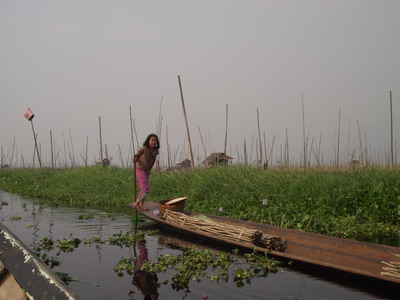
On our third day, faced
with visiting another
three pagodas,
I gave Eitan the morning off and choose instead to walk up a hill 300
meters
high to
visit the forest monastery Maing Thauk. When the boat landed we saw
families
walking to the various shrines. The woman, on their heads, carry
bowls laden with
offerings
to Buddha. In the monastery above we
later saw that the bowls were placed in front of a Buddha statue as an
offering and later removed and taken back home to share with the
families.
The nicest things about
the monastery was that I
was the
only “European” there and there was not even one shop in sight!
Families were
seated in the shade and eating, having given the monks a portion of
their food.
At 9.30 a gong was sounded and the novice monks – young boys around 10
years of
age - came running to get their morning
snack. They looked as boisterous as most
young boys.

A new meaning to "8 seater car"
The shops were closed
for the festival but we
found a
restaurant near our hotel with really good food and best of all – green
tea milkshake!
The next day was New Year and the three day water festival was over, thank goodness; by this time we were out-watered. On New Year, the same people who had been in the streets the day before wetting and getting wet were transformed into people quietly making a pilgrimage to the huge Shwedagon temple complex. Together with the locals we took an elevator to the platform at the top of the hill and visited various shrines
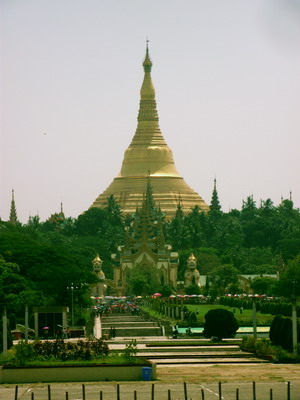

. Everywhere there were
people who were offering (for
merit) the
hundreds of thousands of visitors free drinks, T-shirts were handed
out, and
nurses were in a special complex offering free check-ups to monks as
well as
first aid to pilgrims suffering from the intense heat. Despite the
totally
packed platform there was no pushing, no arguments and we heard no
children
crying. Our guide had brought a book that worked out which day of the
week one
is born. Eitan was born on a Saturday and his sign is a dragon; I was
born on a
Sunday and my sign is a garuda, a mythical bird. We watched as people
whose
birthday occurred that Wednesday offered garlands of flowers and burnt
incense
before the small Wednesday statue. They then poured small cups of water
over
the statue, one for every year and an additional one for the coming
year – just
as we lift children according to the number of years at their birthday
and one
for the next year.
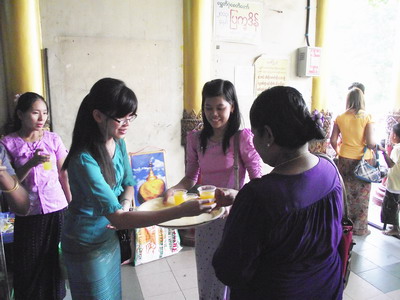
Young couples placed
gold leaf on a small statue of
a baby
boy, hoping to influence the sex of their yet unborn child. We walked
down the
steps to our car amazed at the constant river of people entering and
leaving the
temple complex.
As if I hadn’t visited enough Pagodas I asked to return to the Reclining Buddha that we had visited the day before. It is a modern Buddha, in white plaster, and on the soles of his feet are 108 squares that tell the story of life – the natural world, the world of inanimate objects and the world of impermanence. The face of Buddha was arresting and the look of compassion was exquisite. While Eitan photographed, I sat and meditated. It was very meaningful.
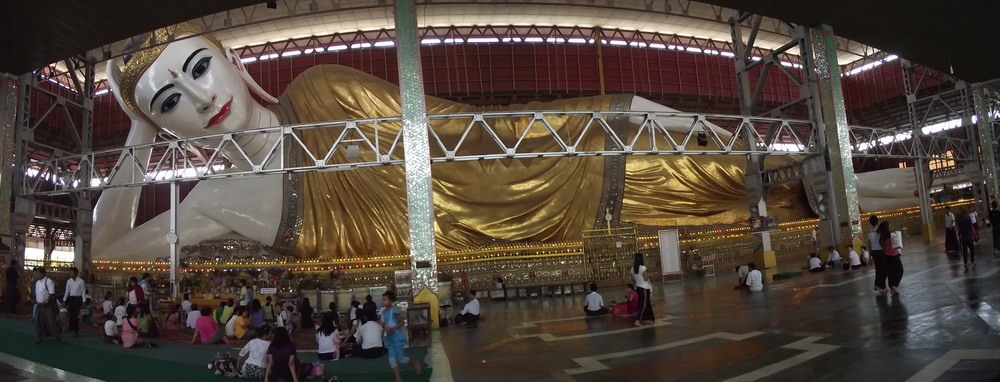
GO TO DOREEN AND EITAN'S HOME PAGE